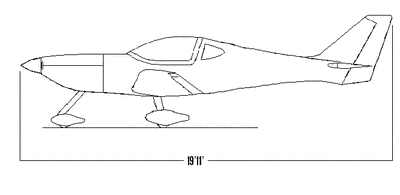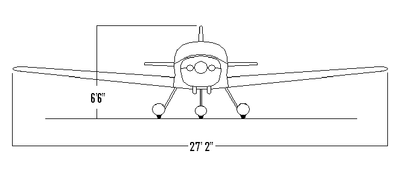The Airplane Struck The Tops Of 75 Ft- To 90 Ft-Tall Trees Bordering The Airport Perimeter
Location: Mount Pleasant, SC Accident Number: ERA20LA150
Date & Time: 04/09/2020, 2100 EDT Registration: N81DJ
Aircraft: Arion Aircraft LLC Lightning LS-1 Injuries: 2 Fatal
Flight Conducted Under: Part 91: General Aviation - Instructional

On April 9, 2020, about 2100 eastern daylight time, an experimental amateur-built Arion Aircraft LLC Lightning LS-1 airplane, N81DJ, was destroyed when it was involved in an accident near Mount Pleasant Regional Airport-Faison Field (LRO) Mount Pleasant, South Carolina. The pilot and the flight instructor were fatally injured. The airplane was operated as a Title 14 Code of Federal Regulations Part 91 instructional flight.
The student pilot, who had recently purchased the airplane, and the flight instructor departed Myrtle Beach International Airport (MYR) Myrtle Beach, South Carolina about 2015. A review of preliminary air traffic control (ATC) communications and radar data provided by the Federal Aviation Administration (FAA) revealed that after departure from runway 36 at MYR the airplane climbed and turned left enroute to LRO, about 65 nautical miles away.
After climbing to an enroute altitude of about 3,000 ft mean sea level (msl) the pilot requested flight following services from ATC. About 15 miles from LRO, the pilot requested a descent into LRO which was approved; the pilot subsequently stated that they wanted to conduct a touch-and-go landing, and that they would be returning to MYR after completing the maneuver. The controller instructed the pilot to remain on their present transponder squawk code and
approved a change to the LRO common traffic advisory frequency. There was no further communication with the pilot.

The airplane entered descending left turn onto final approach to LRO runway 17; the last radar target showed the airplane at an altitude of 525 ft on final to the runway. About 8 minutes later, ATC was notified by local law enforcement that a witness had reported that they heard an aircraft engine "spool up and cut out" near the airport.
A line service employee at MYR reported that the day before the accident flight the pilot and flight instructor completed a flight during the day. When they arrived back at MYR, they requested a fuel top off. The employee put 6.2 gallons of aviation fuel on board, which topped off both fuel tanks. No additional flights were flown until the accident flight the following evening.
Another witness stated that on the evening of the accident, the pilot and flight instructor informed her that they would be conducting a night flight and they would return late. She reported that both pilots appeared to be in good spirits as they left the building, and that the airplane's departure from MYR appeared "normal."
An FAA inspector examined the wreckage at the accident site and reported that the airplane impacted heavily wooded flat terrain about ½-mile south of the departure end of runway 17.
The airplane struck the tops of 75 ft- to 90 ft-tall trees bordering the airport perimeter; several broken tree limbs, branches, and small pieces of fiberglass and plexiglass were found near the mature trees next to the perimeter security fence. The debris path beyond that point was about 250 feet long.
The airplane was heavily fragmented during the accident sequence. Both wings were separated and were broken in multiple pieces; the main wing spar was separated from the wings in its entirety. All primary flight control surfaces were separated from their respective locations and found along the wreckage path. The fuselage was heavily fragmented. The engine separated from the firewall but remained attached to the lower engine mounts and was covered by the engine cowling.

A portion of the fixed pitch propeller remained attached to the propeller flange and engine. The spinner was crushed, and one propeller blade was fractured and separated near its root.
Eighteen inches of the opposing blade remained attached to the flange and was cleanly broken. A 15-+inch-long section of propeller blade was found near the main wreckage and appeared intact outboard of the break.
Flight control continuity could not be established due to the damage to all control surfaces, wings, empennage, and cockpit. Several flight control cables were found separated, and all of the separations displayed features consistent with overload.
Continuity of the fuel system could not be confirmed. Both fuel tanks were breached, and the fuel selector valve was separated from the fuselage. The valve handle was found in the left tank position.
The airplane was recovered to a secure facility and retained for further examination.
 ANN's Daily Aero-Term (04.24.24): Runway Lead-in Light System
ANN's Daily Aero-Term (04.24.24): Runway Lead-in Light System ANN's Daily Aero-Linx (04.24.24)
ANN's Daily Aero-Linx (04.24.24) Aero-FAQ: Dave Juwel's Aviation Marketing Stories -- ITBOA BNITBOB
Aero-FAQ: Dave Juwel's Aviation Marketing Stories -- ITBOA BNITBOB Classic Aero-TV: Best Seat in The House -- 'Inside' The AeroShell Aerobatic Team
Classic Aero-TV: Best Seat in The House -- 'Inside' The AeroShell Aerobatic Team Airborne Affordable Flyers 04.18.24: CarbonCub UL, Fisher, Affordable Flyer Expo
Airborne Affordable Flyers 04.18.24: CarbonCub UL, Fisher, Affordable Flyer Expo





